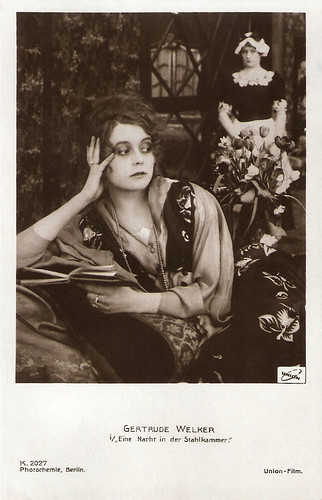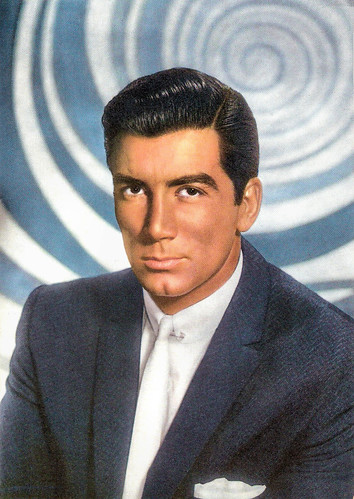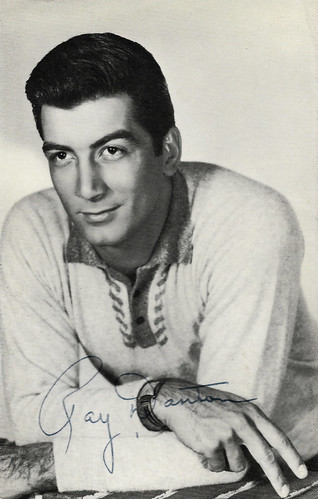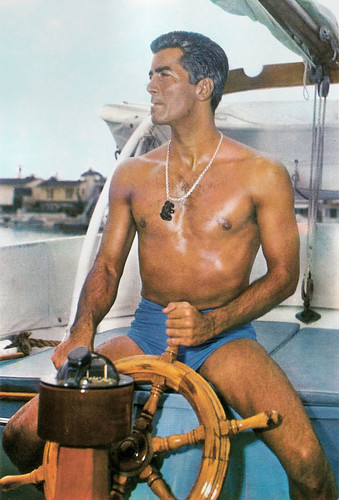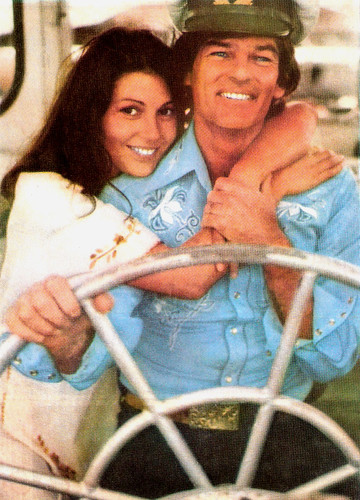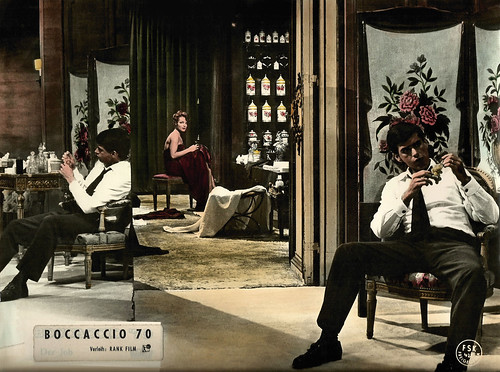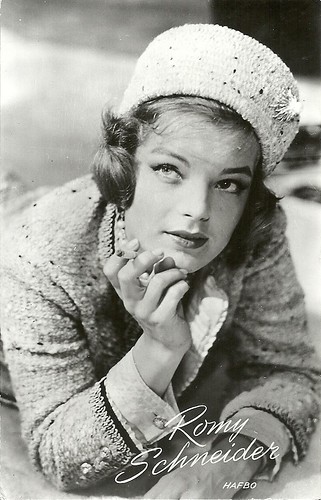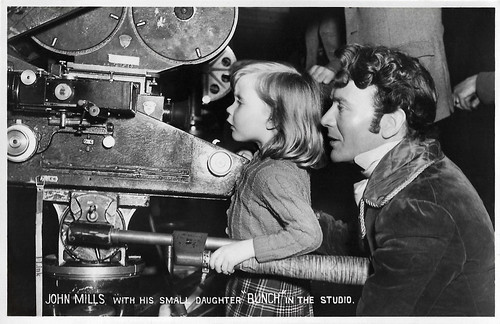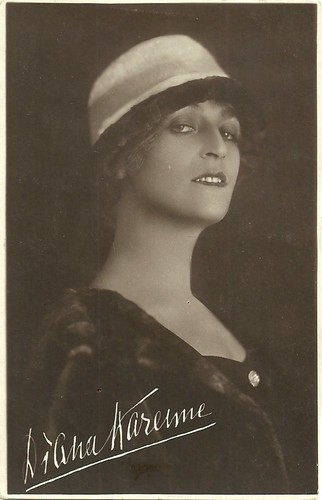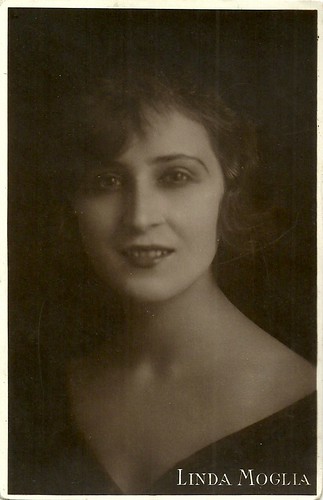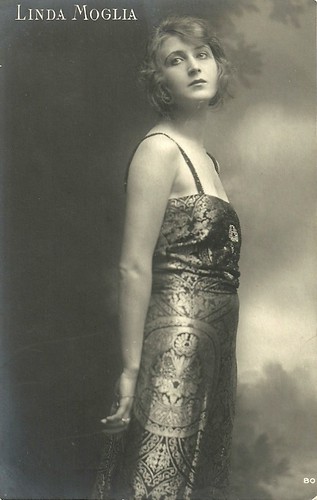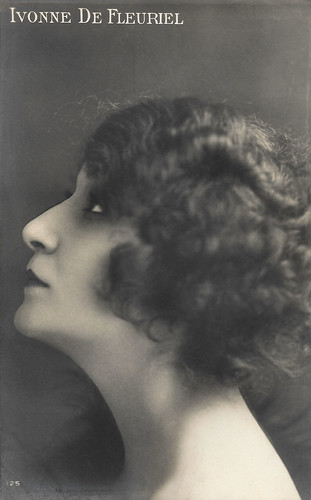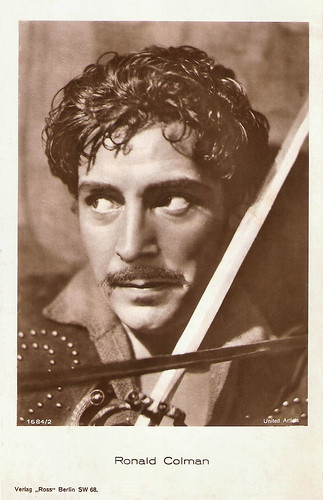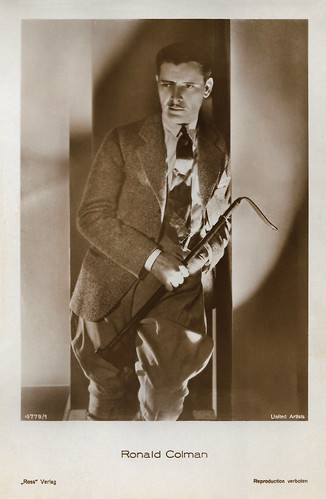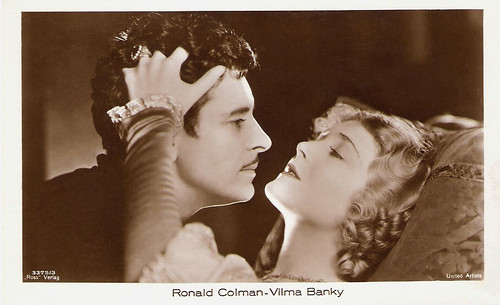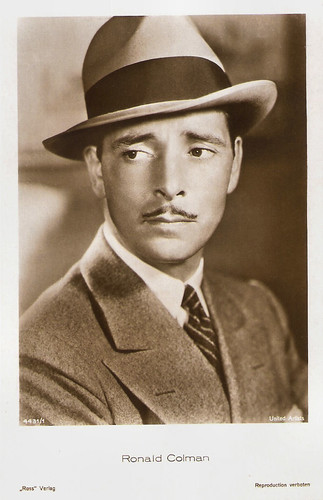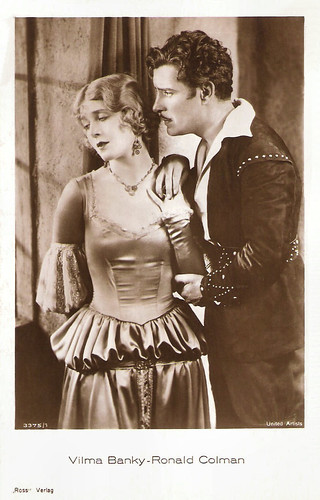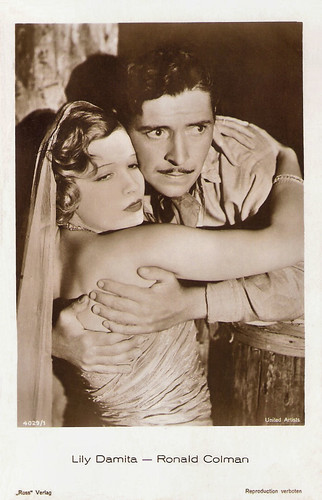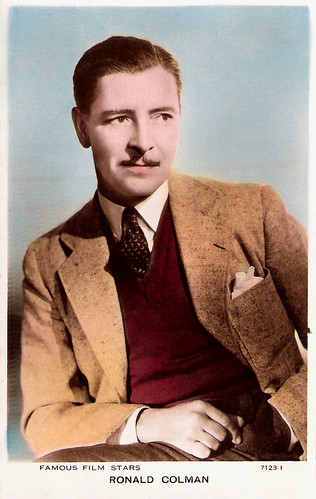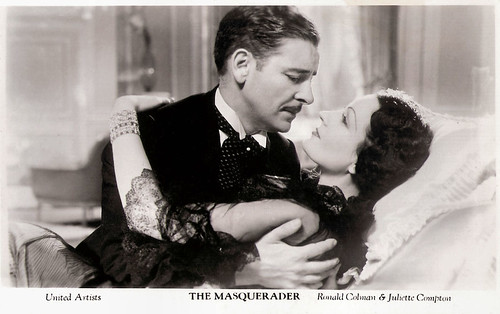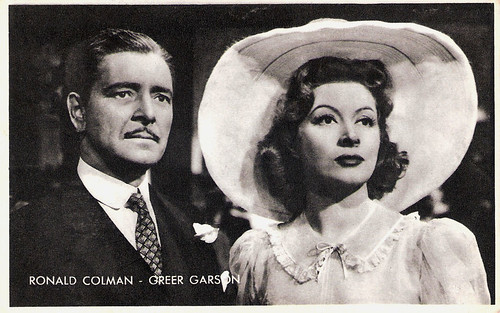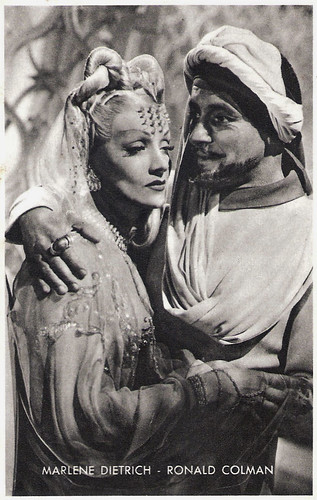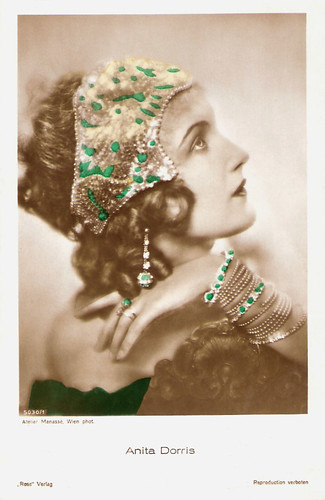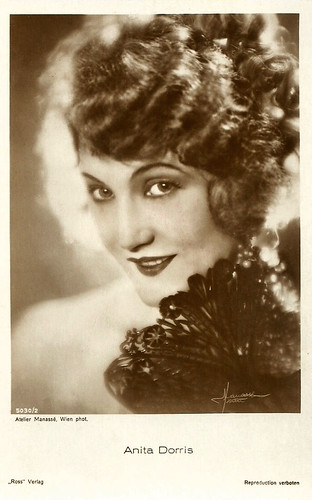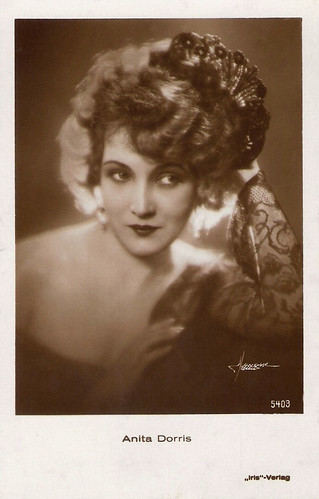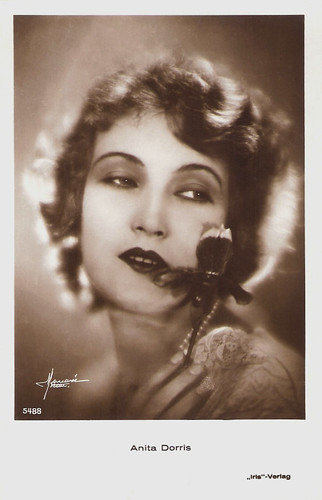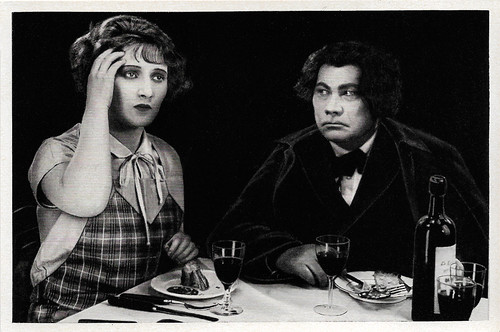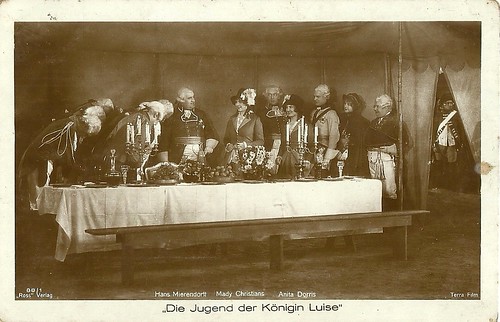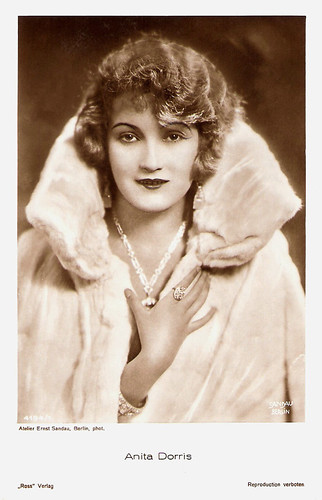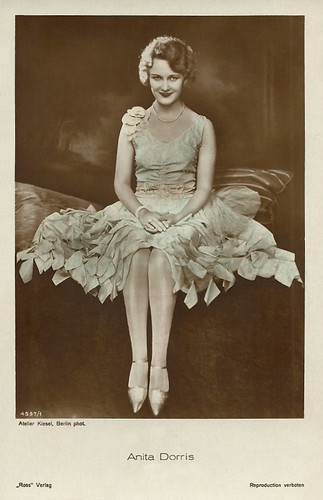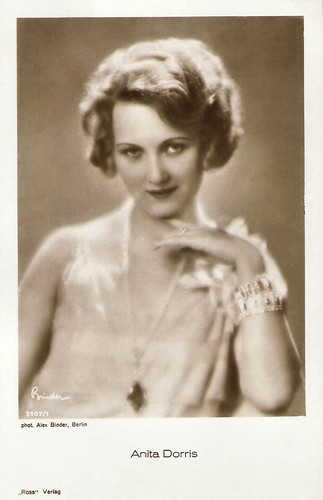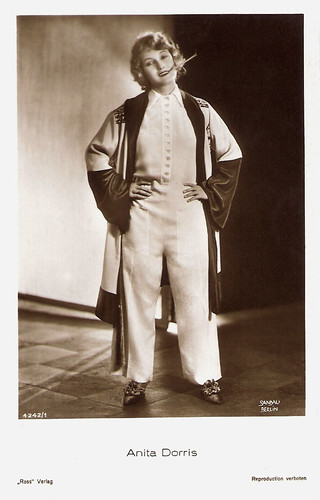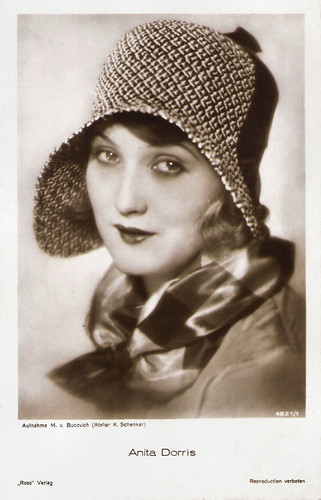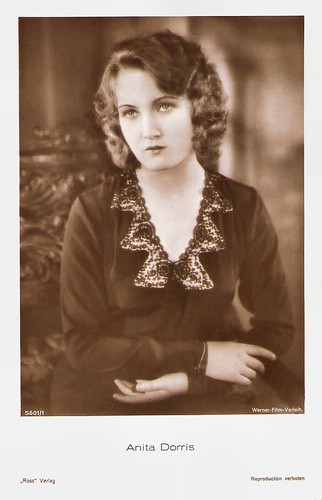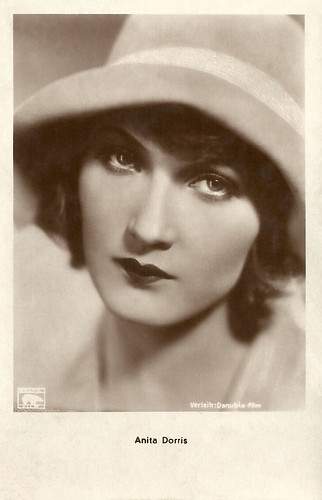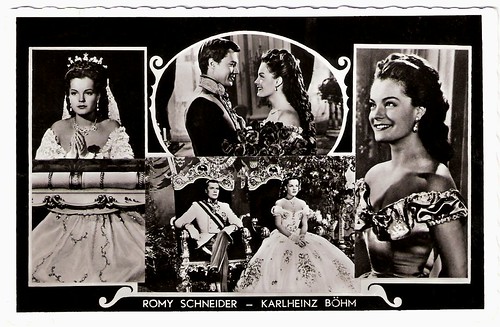In the Swinging Sixties, shy, awkward-looking British actress Jane Birkin (1946) made a huge international splash as one of the nude models in Antonioni's Blow-Up (1966). In France she became the muse of singer-songwriter Serge Gainsbourg, who wrote several of her albums, plus their explicitly erotic duet Je t'aime... moi non plus. Later she worked with such respected film directors as Jacques Rivette, Agnès Varda and Jacques Doillon, and won several acting awards.
![Jane Birkin]()
French postcard by V, Paris, no. 95022. Photo: Bernard Leloup / Salut. Promotion card for the Fontana album Ex fan des sixties.
![Jane Birkin]()
Romanian postcard by Casa Filmului Acin, no. 33102.
![Jane Birkin]()
French postcard. Photo: Phonogram/Raymond Bounon. Publicity still for the record Baby alone in Baylone (1983).
![Jane Birkin]()
French postcard by Éditions Damilla, Paris, no. 95022. Photo: R. Melloul / SYGMA.
Jane Mallory Birkin was born in London in 1946. Her mother, Judy Campbell, was an English stage actress, and her father, David Birkin, was a Royal Navy lieutenant-commander, who had worked on clandestine operations as navigator with the French Resistance. Her brother is the screenwriter and director Andrew Birkin. She was educated at Upper Chine School, Isle of Wight, and then went to Kensington Academy in London.
At 17, she first went on stage in Graham Greene's 1964 production Carving a Statue. A year later she was chosen to play in the musical comedy Passion Flower Hotel with music by John Barry (composer of the James Bond theme). They met and married shortly afterwards. Their daughter Kate Barry, now a photographer, was born in 1967.
Jane emerged in the Swinging London scene of the 1960s. First she appeared uncredited as a girl on a motorbike in the comedy The Knack …and How to Get It (Richard Lester, 1965) starring Rita Tushingham. Then she attracted attention with a brief scene as a nude, blonde model in Blowup (1966), Michelangelo Antonioni's scandalous masterpiece that received the Palme d'or award at the Cannes Film Festival.
In 1968, Birkin played a fantasy-like model in the psychedelic picture Wonderwall (Joe Massot, 1968). That same year, she auditioned in France for the lead female role in Slogan (Pierre Grimblat, 1969) with pop star Serge Gainsbourg, who was still grieving after his break up with Brigitte Bardot. Jane barely spoke French, and Gainsbourg gave her a rough time. When she burst into tears, mixing private sadness about John Barry and the film part, he disapproved, but he recognised that she cried well in front of the camera. Jane got the part, and a mythical and passionate Paris love story began.
Birkin performed with Gainsbourg on the film's theme song, La chanson de slogan— the first of many collaborations between the two. They became inseparable and a living legend when they recorded the duet Je t'aime... moi non plus (I love you... me neither), a song Gainsbourg originally had written for Brigitte Bardot. The song's fame is partly a result of its salacious lyrics, sung by Gainsbourg and Birkin to a background of passionate whispering and moaning from Birkin, concluding in her simulated orgasm. Censorship in several countries went wild, the Vatican condemned the immoral nature of the song, and in Great Britain the BBC refused to play the original, and did their own orchestral version. The record benefited from all the free publicity and rocketed straight to the top of the charts, selling a million copies in a matter of months.
![Jane Birkin in Slogan (1969)]()
Romanian postcard by Casa Filmului Acin, no. 448. Photo: publicity still for Slogan (Pierre Grimblat, 1969).
![Serge Gainsbourg and Jane Birkin]()
French card. With Serge Gainsbourg.
![Serge Gainsbourg and Jane Birkin]()
French autograph card. With Serge Gainsbourg.
![Jane Birkin]()
French postcard by Éditions Damilla, Paris, no. 95023. Photo: Dominique Issermann / SYGMA.
At the Côte d'Azur, Jane Birkin played in the thriller La Piscine/The Swimming Pool (Jacques Deray, 1969) in which she was seduced by Alain Delon. Then she went with Serge Gainsbourg to Yugoslavia to play in the adventure film Romansa konjokradice/Romance of a horse thief (Abraham Polonsky, 1971) starring Yul Brynner.
In 1971 her daughter, the actress and singer Charlotte Gainsbourg was born. Birkin took a break from acting, but returned as the lover of Brigitte Bardot (in her final film role) in Don Juan ou Si Don Juan était une femme.../Don Juan 73 (Roger Vadim, 1973). Her first solo album, Di Doo Dah, was also released in 1973. The title song became another chart hit.
In the cinema Birkin played 'cute but stupid' roles in box office hits as La moutarde me monte au nez/Lucky Pierre (Claude Zidi, 1974) and La course à l’échalotte/The Wild Goose Chase (Claude Zidi, 1975), two popular comedies starring Pierre Richard. She proved herself as a film actress in Le Mouton enragé/Love at the Top (Michel Deville, 1974) starring Romy Schneider, and the highly dramatic Sept morts sur ordonnance/Seven Deaths by Prescription (Jacques Rouffio, 1975) opposite Michel Piccoli.
In 1975, she also appeared with Joe Dallesandro in Gainsbourg's daring directorial début Je t'aime... moi non plus (Serge Gainsbourg, 1976). The film created a stir for its frank examination of sexual ambiguity and the controversial sex scenes. For her performance as an androgynous looking teenager she was nominated for a Best Actress César Award.
In the meantime, her second album Lolita go home (1975) came out, on which she sang Philippe Labro's lyrics set to Gainsbourg's music. Three years later, her Ex-fan des sixties (1978) was released.
Birkin starred in a series of mainstream films such as L'Animal/Stuntwoman (Claude Zidi, 1977) with Jean-Paul Belmondo, and the Agatha Christie films Death on the Nile (John Guillermin, 1978) and Evil Under the Sun (Guy Hamilton, 1982), with Peter Ustinov as Belgian detective Hercule Poirot. In the arthouse production Egon Schiele Exzess und Bestrafung/Egon Schiele: Excess and Punishment (Herbert Vesely, 1980), she appeared as the mistress of Austrian artist Egon Schiele, played by Mathieu Carrière.
![Jane Birkin]()
French postcard by Ëditions du Désastre, Boulogne, no. PK 2, 1982. Photo: Peter Knapp, 1980.
![Jane Birkin]()
Swiss postcard by Musée de l'Elysée/News Productions, Baulmes, no. 55594. Photo: Laurence Sudre.
![Jane Birkin]()
French postcard by Editions Marion-Valentine, Paris, no. N-177. Photo: Dominique Issermann. Caption: Jane Birkin 1981.
![Jane Birkin]()
French postcard by Editions Marion-Valentine, Paris, no. N-176. Photo: Dominique Issermann. Caption: Jane Birkin 1983.
Serge Gainsbourg had plunged into several major bouts of alcoholism and depression, resulting in all-night partying and scandals, and in 1980 Jane Birkin left him. The couple remained on good terms though. Birkin starred as Anne in La fille prodigue/The Prodigal Daughter (Jacques Doillon, 1981).
Jacques Doillon proved to be her dream of a director, who imposed his own personal style of drama, and brought out the very best of her. She went to live with him, and in 1982 she had her third daughter Lou Doillon. She also appeared as Alma opposite Maruschka Detmers in his La pirate/The Pirate (Jacques Doillon, 1984), for which she was nominated for a César Award.
This work led to an invitation from theatre director Patrice Chéreau to star on stage in La Fausse suivante (The False Servant) by Pierre de Marivaux. Gainsbourg, suffering from the separation, wrote Baby alone in Babylone for her. The record won the Charles Cross award and became a gold record. She began to appear frequently on stage in plays and concerts in France, Japan, the U.K. and then the U.S.
Film director Jacques Rivette collaborated with her in L'amour par terre/Love on the Ground (Jacques Rivette, 1983) starring Geraldine Chaplin, and La Belle Noiseuse/The Beautiful Troublemaker (Jacques Rivette, 1991) with Michel Piccoli and Emmanuelle Béart. Again Birkin was nominated for the César for best supporting actress, for both films.
She created a sensation as star and screenwriter of director Agnès Varda's Kung Fu Master (1987), in which she played a 40-year-old woman carrying on a torrid affair with a 15-year-old boy, played by Mathieu Demy, Varda's son. The following year, Varda expressed her admiration for Birkin with the feature-length documentary Jane B. par Agnes V (Agnès Varda, 1988).
Birkin’s work in Dust (Marion Hänsel, 1985) with Trevor Howard, and Daddy Nostalgie (Bertrand Tavernier, 1990) opposite Dirk Bogarde also earned her the praise and respect of international critics. Additionally, she appeared in Merchant Ivory's A Soldier's Daughter Never Cries (James Ivory, 1998) and Merci Docteur Rey (Andrew Litvack, 2002) with Dianne Wiest, while the end title song of Le Divorce (James Ivory, 2003) featured her singing L'Anamour, composed by Serge Gainsbourg.
In 1990 Serge Gainsbourg dedicated a new album to her: Amours des feintes. It was to be his last. He died in 1991. A year later Birkin won the Female Artist of the Year award at the 1992 Victoires de la Musique. In 1993 she separated from Jacques Doillon. In the following years she devoted herself to her family and to her humanitarian work with Amnesty International on immigrant welfare and AIDS issues. Birkin visited Bosnia, Rwanda and Palestine, often working with children.
In 2001, she was awarded the OBE in Great Britain. She has also been awarded the French Ordre national du Mérite in 2004. Jane Birkin continues to make films, theatre and music. She collaborated with such artists as Bryan Ferry, Manu Chao, Françoise Hardy, Rufus Wainwright, and Les Negresses Vertes on albums as Rendez-Vous (2004) and Fictions (2006). The self-penned Enfants d'Hiver arrived in 2008.
In 2006, Birkin played the title role in Elektra, directed by Philippe Calvario in France. At the Cannes Film Festival 2007, she presented a film, both as a director and actor: Boxes (2007) with Michel Piccoli, Geraldine Chaplin, and her daughter Lou Doillon.
She also appeared in Si tu meurs, je te tue/If you die, I’ll kill you (Hiner Saleem, 2011) with Jonathan Zaccaï, and La femme et le TGV/The Railroad Lady (2016), a short film directed by Swiss filmmaker Timo von Gunten. The film was nominated for an Academy Award for Best Live Action Short Film. In a 2017 interview, Birkin stated that La femme et le TGV would be her final acting performance, and that she had no plans to return to acting.
In March 2017, Jane Birkin released Birkin/Gainsbourg: Le Symphonique, a collection of songs Serge Gainsbourg had written for her during and after their relationship, reworked with full orchestral arrangements.
![Jane Birkin]()
French postcard, no. C 4477.
![Jane Birkin]()
Romanian postcard by Casa Filmului Acin. Photo: publicity still for Jane. B par Agnes V. (Agnes Varda, 1987).
![Jane Birkin]()
French postcard in the Signes du Zodiaque series by Editions F. Nugeron, no. 13 - Sagittaire (Sagittarius).
Trailer Wonderwall (1968). Source: Our Man in Havana (YouTube).
Trailer Slogan (1969). Source: 7173Productions (YouTube).
Jane Birkin sings Quoi (1995). Source: bcbauer (YouTube).
Sources: Hal Erickson (AllMovie), John Bush (AllMusic), RFI Musique, Wikipedia, and IMDb.

French postcard by V, Paris, no. 95022. Photo: Bernard Leloup / Salut. Promotion card for the Fontana album Ex fan des sixties.

Romanian postcard by Casa Filmului Acin, no. 33102.

French postcard. Photo: Phonogram/Raymond Bounon. Publicity still for the record Baby alone in Baylone (1983).

French postcard by Éditions Damilla, Paris, no. 95022. Photo: R. Melloul / SYGMA.
A mythical and passionate Paris love story
Jane Mallory Birkin was born in London in 1946. Her mother, Judy Campbell, was an English stage actress, and her father, David Birkin, was a Royal Navy lieutenant-commander, who had worked on clandestine operations as navigator with the French Resistance. Her brother is the screenwriter and director Andrew Birkin. She was educated at Upper Chine School, Isle of Wight, and then went to Kensington Academy in London.
At 17, she first went on stage in Graham Greene's 1964 production Carving a Statue. A year later she was chosen to play in the musical comedy Passion Flower Hotel with music by John Barry (composer of the James Bond theme). They met and married shortly afterwards. Their daughter Kate Barry, now a photographer, was born in 1967.
Jane emerged in the Swinging London scene of the 1960s. First she appeared uncredited as a girl on a motorbike in the comedy The Knack …and How to Get It (Richard Lester, 1965) starring Rita Tushingham. Then she attracted attention with a brief scene as a nude, blonde model in Blowup (1966), Michelangelo Antonioni's scandalous masterpiece that received the Palme d'or award at the Cannes Film Festival.
In 1968, Birkin played a fantasy-like model in the psychedelic picture Wonderwall (Joe Massot, 1968). That same year, she auditioned in France for the lead female role in Slogan (Pierre Grimblat, 1969) with pop star Serge Gainsbourg, who was still grieving after his break up with Brigitte Bardot. Jane barely spoke French, and Gainsbourg gave her a rough time. When she burst into tears, mixing private sadness about John Barry and the film part, he disapproved, but he recognised that she cried well in front of the camera. Jane got the part, and a mythical and passionate Paris love story began.
Birkin performed with Gainsbourg on the film's theme song, La chanson de slogan— the first of many collaborations between the two. They became inseparable and a living legend when they recorded the duet Je t'aime... moi non plus (I love you... me neither), a song Gainsbourg originally had written for Brigitte Bardot. The song's fame is partly a result of its salacious lyrics, sung by Gainsbourg and Birkin to a background of passionate whispering and moaning from Birkin, concluding in her simulated orgasm. Censorship in several countries went wild, the Vatican condemned the immoral nature of the song, and in Great Britain the BBC refused to play the original, and did their own orchestral version. The record benefited from all the free publicity and rocketed straight to the top of the charts, selling a million copies in a matter of months.

Romanian postcard by Casa Filmului Acin, no. 448. Photo: publicity still for Slogan (Pierre Grimblat, 1969).

French card. With Serge Gainsbourg.

French autograph card. With Serge Gainsbourg.

French postcard by Éditions Damilla, Paris, no. 95023. Photo: Dominique Issermann / SYGMA.
Cute But Stupid
At the Côte d'Azur, Jane Birkin played in the thriller La Piscine/The Swimming Pool (Jacques Deray, 1969) in which she was seduced by Alain Delon. Then she went with Serge Gainsbourg to Yugoslavia to play in the adventure film Romansa konjokradice/Romance of a horse thief (Abraham Polonsky, 1971) starring Yul Brynner.
In 1971 her daughter, the actress and singer Charlotte Gainsbourg was born. Birkin took a break from acting, but returned as the lover of Brigitte Bardot (in her final film role) in Don Juan ou Si Don Juan était une femme.../Don Juan 73 (Roger Vadim, 1973). Her first solo album, Di Doo Dah, was also released in 1973. The title song became another chart hit.
In the cinema Birkin played 'cute but stupid' roles in box office hits as La moutarde me monte au nez/Lucky Pierre (Claude Zidi, 1974) and La course à l’échalotte/The Wild Goose Chase (Claude Zidi, 1975), two popular comedies starring Pierre Richard. She proved herself as a film actress in Le Mouton enragé/Love at the Top (Michel Deville, 1974) starring Romy Schneider, and the highly dramatic Sept morts sur ordonnance/Seven Deaths by Prescription (Jacques Rouffio, 1975) opposite Michel Piccoli.
In 1975, she also appeared with Joe Dallesandro in Gainsbourg's daring directorial début Je t'aime... moi non plus (Serge Gainsbourg, 1976). The film created a stir for its frank examination of sexual ambiguity and the controversial sex scenes. For her performance as an androgynous looking teenager she was nominated for a Best Actress César Award.
In the meantime, her second album Lolita go home (1975) came out, on which she sang Philippe Labro's lyrics set to Gainsbourg's music. Three years later, her Ex-fan des sixties (1978) was released.
Birkin starred in a series of mainstream films such as L'Animal/Stuntwoman (Claude Zidi, 1977) with Jean-Paul Belmondo, and the Agatha Christie films Death on the Nile (John Guillermin, 1978) and Evil Under the Sun (Guy Hamilton, 1982), with Peter Ustinov as Belgian detective Hercule Poirot. In the arthouse production Egon Schiele Exzess und Bestrafung/Egon Schiele: Excess and Punishment (Herbert Vesely, 1980), she appeared as the mistress of Austrian artist Egon Schiele, played by Mathieu Carrière.

French postcard by Ëditions du Désastre, Boulogne, no. PK 2, 1982. Photo: Peter Knapp, 1980.

Swiss postcard by Musée de l'Elysée/News Productions, Baulmes, no. 55594. Photo: Laurence Sudre.

French postcard by Editions Marion-Valentine, Paris, no. N-177. Photo: Dominique Issermann. Caption: Jane Birkin 1981.

French postcard by Editions Marion-Valentine, Paris, no. N-176. Photo: Dominique Issermann. Caption: Jane Birkin 1983.
The Very Best of Her
Serge Gainsbourg had plunged into several major bouts of alcoholism and depression, resulting in all-night partying and scandals, and in 1980 Jane Birkin left him. The couple remained on good terms though. Birkin starred as Anne in La fille prodigue/The Prodigal Daughter (Jacques Doillon, 1981).
Jacques Doillon proved to be her dream of a director, who imposed his own personal style of drama, and brought out the very best of her. She went to live with him, and in 1982 she had her third daughter Lou Doillon. She also appeared as Alma opposite Maruschka Detmers in his La pirate/The Pirate (Jacques Doillon, 1984), for which she was nominated for a César Award.
This work led to an invitation from theatre director Patrice Chéreau to star on stage in La Fausse suivante (The False Servant) by Pierre de Marivaux. Gainsbourg, suffering from the separation, wrote Baby alone in Babylone for her. The record won the Charles Cross award and became a gold record. She began to appear frequently on stage in plays and concerts in France, Japan, the U.K. and then the U.S.
Film director Jacques Rivette collaborated with her in L'amour par terre/Love on the Ground (Jacques Rivette, 1983) starring Geraldine Chaplin, and La Belle Noiseuse/The Beautiful Troublemaker (Jacques Rivette, 1991) with Michel Piccoli and Emmanuelle Béart. Again Birkin was nominated for the César for best supporting actress, for both films.
She created a sensation as star and screenwriter of director Agnès Varda's Kung Fu Master (1987), in which she played a 40-year-old woman carrying on a torrid affair with a 15-year-old boy, played by Mathieu Demy, Varda's son. The following year, Varda expressed her admiration for Birkin with the feature-length documentary Jane B. par Agnes V (Agnès Varda, 1988).
Birkin’s work in Dust (Marion Hänsel, 1985) with Trevor Howard, and Daddy Nostalgie (Bertrand Tavernier, 1990) opposite Dirk Bogarde also earned her the praise and respect of international critics. Additionally, she appeared in Merchant Ivory's A Soldier's Daughter Never Cries (James Ivory, 1998) and Merci Docteur Rey (Andrew Litvack, 2002) with Dianne Wiest, while the end title song of Le Divorce (James Ivory, 2003) featured her singing L'Anamour, composed by Serge Gainsbourg.
In 1990 Serge Gainsbourg dedicated a new album to her: Amours des feintes. It was to be his last. He died in 1991. A year later Birkin won the Female Artist of the Year award at the 1992 Victoires de la Musique. In 1993 she separated from Jacques Doillon. In the following years she devoted herself to her family and to her humanitarian work with Amnesty International on immigrant welfare and AIDS issues. Birkin visited Bosnia, Rwanda and Palestine, often working with children.
In 2001, she was awarded the OBE in Great Britain. She has also been awarded the French Ordre national du Mérite in 2004. Jane Birkin continues to make films, theatre and music. She collaborated with such artists as Bryan Ferry, Manu Chao, Françoise Hardy, Rufus Wainwright, and Les Negresses Vertes on albums as Rendez-Vous (2004) and Fictions (2006). The self-penned Enfants d'Hiver arrived in 2008.
In 2006, Birkin played the title role in Elektra, directed by Philippe Calvario in France. At the Cannes Film Festival 2007, she presented a film, both as a director and actor: Boxes (2007) with Michel Piccoli, Geraldine Chaplin, and her daughter Lou Doillon.
She also appeared in Si tu meurs, je te tue/If you die, I’ll kill you (Hiner Saleem, 2011) with Jonathan Zaccaï, and La femme et le TGV/The Railroad Lady (2016), a short film directed by Swiss filmmaker Timo von Gunten. The film was nominated for an Academy Award for Best Live Action Short Film. In a 2017 interview, Birkin stated that La femme et le TGV would be her final acting performance, and that she had no plans to return to acting.
In March 2017, Jane Birkin released Birkin/Gainsbourg: Le Symphonique, a collection of songs Serge Gainsbourg had written for her during and after their relationship, reworked with full orchestral arrangements.

French postcard, no. C 4477.

Romanian postcard by Casa Filmului Acin. Photo: publicity still for Jane. B par Agnes V. (Agnes Varda, 1987).

French postcard in the Signes du Zodiaque series by Editions F. Nugeron, no. 13 - Sagittaire (Sagittarius).
Trailer Wonderwall (1968). Source: Our Man in Havana (YouTube).
Trailer Slogan (1969). Source: 7173Productions (YouTube).
Jane Birkin sings Quoi (1995). Source: bcbauer (YouTube).
Sources: Hal Erickson (AllMovie), John Bush (AllMusic), RFI Musique, Wikipedia, and IMDb.




